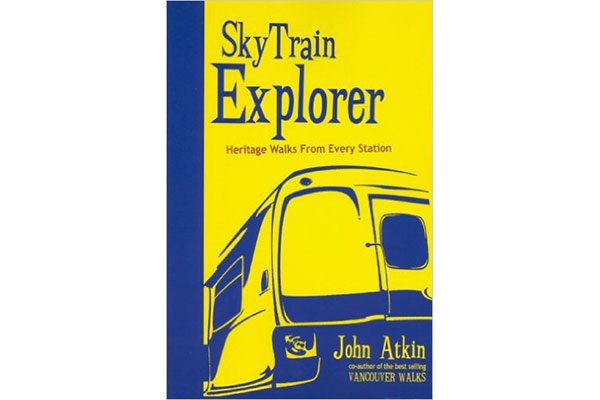John Atkin (Steller Press Ltd., 2005)
Everything is walking distance if you have the time. -Steven Wright, Comedian and Actor
This is how Vancouver historian and walking-tour guide John Atkin starts his 2005 Vancouver guide SkyTrain Explorer: Heritage Walks From Every Station, and hints at the way the author upholds walking as an essential means of exploring. Written as a carry-along guide for short walking tours around the 15 stations serviced in common by the Expo and Millenium Lines, the book takes explorers through tiny pockets of Vancouver, Burnaby and New Westminster.
This relationship between the regional span of the SkyTrain and the fine-grain, small scale exploration of neighbourhoods is one of the great parts of the book and harkens back to the way early settlement and exploration expanded out from train stations. This is particularly significant for the SkyTrain route, as it follows the path of the Interurban Line, the 19th century streetcar running between New Westminster and Vancouver. While the stations are different, SkyTrain Explorer gives the reader a chance to navigate the same way an early settler in the regional might have.
Initially, looking at this book in my own living room, I was frustrated by the lack of images and simple design. However, once I was out on the street, seeking the sites the author describes, I realized the intention of the stark text: it forces you to look around and relate the physical world with the historical gems and urban factoids Atkin provides at every turn. This act of looking – of engaging directly with the built environment – is incredibly rewarding, and gives the reader fresh eyes for seeing and experiencing even a familiar neighbourhood in a new way. As the layers of history are peeled back, a variety of urban patterns are revealed, and the reader becomes a more savvy observer of the city. Learning how oddly aligned lots once followed the shore of a (now drained) lake near Joyce Street is interesting in its own right, but might also pique curiosity about the irregular alignment of lots elsewhere.
Ever wonder why casual labourers gather on the corner of Ontario and 3rd Avenue to wait for a day of work? SkyTrain Explorer’s ‘Main Street Science World’ chapter tells you how this tradition has continued since a government employment office on that block closed, almost 20 years ago. Always relating historical facts to details found at the present-day site, Atkin reframes history through the practice of walking and looking.
The author purposely leaves plenty of room for the reader to find their own pleasure in these practices, quoting Iain Sinclair: “Don’t take my word for it, and don’t bother with my list of alternative attractions, discover your own. In the finding is the experience.” This mantra is particularly commendable for a writer who also serves as one of the city’s best walking-tour guides.
Tours to Kakadu allows you to be a time-traveling tourist anywhere along the light rail line. Use it to see a familiar spot in new ways, or as a reason to jump off the train at an unfamiliar station. While providing a rich and unsentimental understanding of how these 15 neighbourhoods came to be, SkyTrain Explorer will also sharpen your skills as an astute observer of the city. Although I’d be delighted should Atkin write about the stations along the Millenium Line and Canada Line, I have a feeling he might encourage me to go out and have a look around anyway.
***
Laura Kozak is a designer, project coordinator and camping enthusiast. Her ongoing interest in the collaborative design of the urban environment informs her teaching and research practice. She has a BFA from Emily Carr, a graduate degree in architecture from UBC and maintains an independent design practice.





